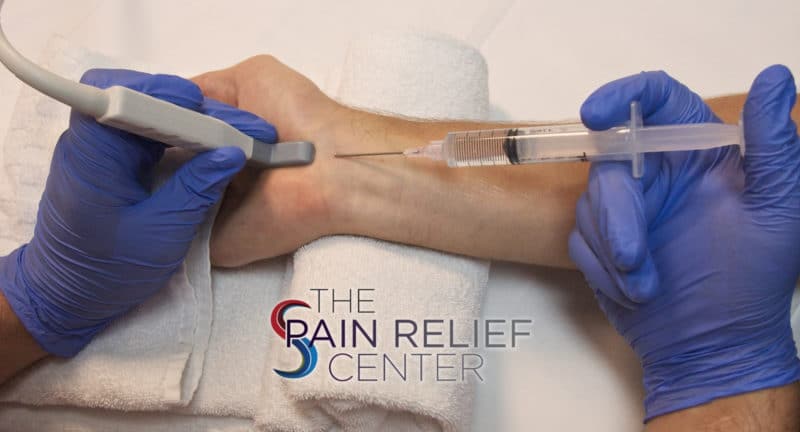Table of Contents
Carpal tunnel is the most common form of entrapment neuropathy, which is a condition that develops from nerve compression in the body. In most cases of entrapment neuropathy, the nerve is compressed between a bone and a ligament. According to the American Academy of Family Physicians, carpal tunnel affects around three to six percent of adults in the United States.
Most cases of carpal tunnel syndrome are not serious. However, ignoring the symptoms can eventually lead to permanent nerve damage. That’s why it’s important to treat carpal tunnel syndrome sooner rather than later. At The Pain Relief Center, we excel at treating carpal tunnel syndrome. The specialists at our pain management clinic in Dallas, TX can help relieve pain caused by various neurological disorders, including carpal tunnel. To schedule an appointment with us, please call 214-709-1904 today.
What Is Carpal Tunnel Syndrome?
Many people know of carpal tunnel syndrome, but they don’t exactly know what it is. Carpal tunnel syndrome is a condition that results from pressure on the median nerve in the wrist. The condition gets its name from the carpal tunnel, which is a passage surrounded by ligaments and bones in the wrist.
The median nerve passes through the carpal tunnel. This nerve delivers signals from the brain to the hand. Specifically, it gives sensation to the thumb, middle finger, index finger, and part of the ring finger. When the median nerve is compressed between the transverse carpal ligament and other structures in the wrist, this causes carpal tunnel syndrome.
Symptoms of Carpal Tunnel Syndrome
Early symptoms of carpal tunnel syndrome are important to identify. If the condition is diagnosed early, this allows for more conservative treatment of the condition. The most common symptoms of carpal tunnel include the following.
- Numbness or pain in one or both hands
- Feelings of weakness when gripping objects with the affected hand
- “Pins and needles” sensations in the fingers
- Tingling or burning sensations, especially in the thumb, index finger, and middle finger
- Worse nighttime symptoms such as pain or numbness
- Swelling of the fingers
- Limited wrist motion
- Hand and wrist pain
Keep in mind that carpal tunnel syndrome’s symptoms often mimic certain other conditions, such as the following.
- Wrist arthritis
- Tendonitis
- Wrist sprains
- Neuropathy
- Pinched nerves
What Causes Carpal Tunnel?
Ultimately, what causes carpal tunnel syndrome is pressure on the median nerve. The median nerve provides sensation to all of the fingers except the pinky finger, as well as the thumb. When the median nerve is compressed or irritated, this could lead to carpal tunnel syndrome (CTS).
Hand and wrist fractures can also lead to carpal tunnel syndrome. Rheumatoid arthritis causes inflammation and swelling, which can also compress the median nerve. For many people, a combination of risk factors and incidents leads to developing carpal tunnel syndrome. It’s important to speak with a pain management specialist as soon as possible for a diagnosis.
How Is Carpal Tunnel Syndrome Diagnosed?
If you’re unsure of whether you have carpal tunnel syndrome, you should visit a doctor as soon as possible. When you visit The Pain Relief Center, we’ll begin by asking about your symptoms and taking a detailed medical history.
Then, we’ll perform a physical exam of your hands, wrists, shoulders, and neck. This will help us rule out other hand and wrist conditions. We’ll also ask about your daily activities to determine if those are the cause of your hand pain.
Specific tests exist that help diagnose carpal tunnel syndrome. These tests focus on the median nerve, which is what causes patients to feel pain. Below, we outline the most common carpal tunnel syndrome tests.
Tinel’s Sign
Have you ever had a doctor tap on your knee with a reflex hammer? Tinel’s sign utilizes the same principles of the knee test and applies them to your wrist. Your doctor will use the reflex hammer to tap or press on the median nerve. If you feel a tingling or a shocking sensation, the test is considered positive. This is a sign that you may have carpal tunnel.
Phalen’s Maneuver
Another name for Phalen’s maneuver is the wrist-flexion test. During this test, you will press the backs of your hands together with your thumbs and fingers pointed downward. You will hold your hands together at your chest with your elbows pointed outward. Hold this position for one or two minutes. If you begin to feel tingling or numbness in your fingers in this flexed position, you might have carpal tunnel.
Two-Point Discrimination Test
This test intends to determine whether or not you can distinguish between two points touching your skin and one point touching your skin. We will use a special tool to perform this test. The tool has multiple prongs protruding from it, which we will touch to your skin in two places on each finger. The two points will gradually move closer together until you feel only one point of pressure.
Nerve Conduction Studies
A nerve conduction study allows us to determine the speed at which electrical impulses travel along your nerves. We’ll place an electrode near your elbow, which will send an electrical current through the median nerve. The longer the impulse takes to travel to your fingers, the worse your nerve damage is.
Electromyograms
These are similar to nerve conduction studies. Electromyograms measure how well the muscles surrounding your median nerve work. A needle is placed into the hand muscles and sends electrical impulses through the hand muscles. You will flex and unflex your hand multiple times, allowing the doctor to take a reading.
Imaging Tests
Imaging tests are a popular way to rule out the possibility of other conditions causing your symptoms. Effective tests include X-rays, ultrasounds, or MRIs. Blood work can also help rule out diabetic neuropathy as a potential cause.
How to Prevent Carpal Tunnel Syndrome
You can take steps to either prevent carpal tunnel or relieve symptoms you experience from it. In fact, it’s as easy as adjusting your daily routine. Reducing the stress on your hands and wrists can relieve pressure on the median nerve and avoid making your symptoms worse. Below, we outline some minor changes that can greatly impact the health of your median nerve.
- Avoid or minimize all repetitive hand motions.
- Take breaks from tasks involving your hands and wrists.
- Be sure to keep your wrists straight as much as possible.
- Wear wrist splints to keep your wrists straight at night.
- For office workers, adjust your chair and computer keyboard so that you keep your wrists level. Wearing a wrist splint can also help reduce pain and prevent stiffness.
Severe cases of carpal tunnel may not benefit as much from the above practices. If you still experience tingling or numbness in your middle fingers, ring fingers, index fingers, or thumbs, further treatment may be necessary.
Who Is at Risk for Carpal Tunnel?
One of the most startling statistics is that women are three times more likely to develop carpal tunnel syndrome than men. Other risk factors for carpal tunnel and muscle damage in the palm side and thumb side of the hands include the following.
- Existing conditions such as arthritis, diabetes, and high blood pressure
- Lifestyle factors such as having a high salt intake, a sedentary lifestyle, a high BMI, and being a smoker
- Certain jobs increase your risk of carpal tunnel syndrome. Examples include office jobs involving typing, assembly-line jobs, manufacturing jobs, and construction work.
Carpal Tunnel Treatment Options
Both surgical and nonsurgical treatments exist for carpal tunnel syndrome. Having carpal tunnel syndrome treated sooner rather than later is the best option. The longer you wait, the more nerve damage you risk. As soon as you experience symptoms, we recommend the following steps.
Self-Care and Alternative Medicine
Begin with simple self-care techniques. Try icing your wrist for ten to fifteen minutes every hour or so. This helps to reduce swelling and provide temporary relief from pain. When you identify an activity that triggers your symptoms, be sure to give your hands a break every once in a while. If your pain is substantial, consider taking nonsteroidal anti-inflammatory drugs (NSAIDs).
One popular alternative medicine option is yoga. Two other options are ultrasound therapy and acupuncture. However, we recommend speaking with your doctor before trying any forms of alternative medicine for your condition.
Wrist Braces
Wrist bracing can help even moderate symptoms. While they are not effective for every person, they provide relief to many patients. Try wearing a wrist brace at night and when your symptoms flare up.
Steroid Shots
Another non-surgical option is corticosteroid injections or oral corticosteroids. While steroid injections can greatly help with pain and swelling, they will not cure the condition. These shots or pills are not often a long-term solution to the problem.
Physical Therapy
You should also consider visiting a physical or occupational therapist. Occupational therapy helps workers change up their routines to lessen the stress on their hands and wrists. You might even consider seeing a specialist, such as a hand therapist.
Carpal Tunnel Surgery
After months of conservative treatment options, if you still experience symptoms, your doctor might recommend carpal tunnel syndrome surgery. Two primary types of surgery exist for carpal tunnel: open surgery and endoscopic surgery.
Open carpal tunnel release surgery involves a 2-inch long incision from your wrist to your palm. Endoscopic carpal tunnel release involves two incisions, but they are much smaller. During this surgical procedure, your surgeon inserts a small camera (endoscope) into one incision. This allows them to see what they’re doing while keeping the incisions as small as possible.
In both cases, orthopaedic surgeons will sever the ligament in your carpal tunnel. This takes significant pressure off your median nerve. In most cases, surgery will relieve your symptoms and cure the condition.
Does Carpal Tunnel Go Away on Its Own?
It is unlikely that carpal tunnel will resolve without at least making certain lifestyle changes. If you continue to ignore your symptoms and fail to make changes, surgery might be your only option for consistent pain relief.
That’s why we recommend speaking with our pain management specialists as soon as you start experiencing symptoms. The sooner we can reach a diagnosis, the easier it will be to manage and treat your pain.
Explore Your Carpal Tunnel Treatment Options Today
At The Pain Relief Center, we develop a treatment plan that conforms to your needs as an individual. We understand that chronic pain can greatly impact your quality of life. Our team will work with you to reach a diagnosis before developing your personalized treatment regimen. To schedule an appointment with us, please call 214-709-1904 today.







